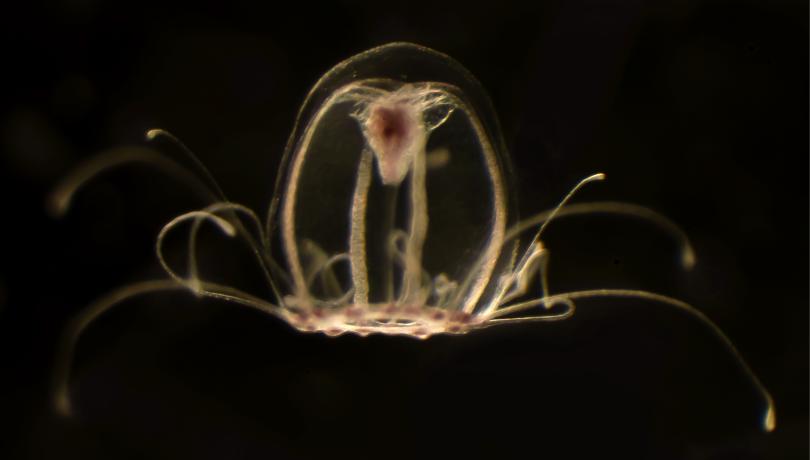In this month’s “In Depth” section, we introduce you to a particularly enigmatic species: the “immortal jellyfish”, one of the main features of the Invisible Animals exhibition, which can be visited until the end of the year at the Natural Sciences Museum of Barcelona.

There are beings capable of defying all the laws of nature. Real creatures that, despite their scientifically proven existence, seem to belong more to the world of myth or fantasy. One of them is Turritopsis dohrnii, better known as the “immortal jellyfish.” This species is the centerpiece of one of the most enigmatic and evocative works in the Invisible Animals exhibition, which includes scientific input and guidance from the Institute of Marine Sciences (ICM-CSIC) and can be visited at the Natural Sciences Museum of Barcelona (MCNB) until 2026.
But the immortal jellyfish is not just a biological curiosity. It opens a window to some of the deepest questions in science and existence: Is it possible to defeat aging? Can biology rewrite the rules of life and death? This species, almost imperceptible to the naked eye with its 4-5 mm diameter, holds a fascinating ability: when it reaches adulthood and has completed its reproductive cycle, it can literally reverse itself, transforming back into a polyp —the preliminary phase in ontogenetic development— through a process of cellular rejuvenation. If this mechanism were to occur indefinitely, Turritopsis dohrnii would never die of natural causes, earning it the nickname “immortal.” However, as a species within an ecosystem, it is still subject to death from predators, infections, etc.
These regenerative abilities sparked the interest of Maria Pascual Torner, ICM-CSIC researcher and creator of the artwork dedicated to this species in the exhibition. In 2022, she published the full genome of Turritopsis dohrnii — a key milestone that launched a new line of research focused on the cellular mechanisms of rejuvenation. The study, published in the journal PNAS, is available here.
“The most fascinating thing about this jellyfish is its ability to rejuvenate, taking biological plasticity to the extreme by reversing its own biological time,” says Pascual-Torner. “It challenges our current understanding of inevitable aging,” adds the researcher, who aimed to reflect this enigma through a series of photographs and visual compositions showing the jellyfish’s life cycle at different stages — creating an installation that oscillates between fragility and persistence, science and symbol.
The piece is part of the "Life" section of the Invisible Animals exhibition, which combines art, science, and storytelling to explore life forms that, although real, go unnoticed: due to their inaccessible habitats, tiny size, or our collective ignorance. Turritopsis dohrnii is a paradigm of this biological invisibility. It has been identified in the Pacific, Atlantic, and Mediterranean (where it originates) seas, but its observation in the wild is nearly impossible. Its regenerative process has only been studied in depth in specialized laboratories.
“What’s most impressive about this phenomenon is that the cellular reprogramming leading to rejuvenation can be organized within such a complex system as an individual organism,” Pascual-Torner emphasizes.
This ability has captured the interest of the international scientific community, which is studying its biology in the hope of finding clues to understand human aging, combat diseases like Alzheimer’s and cancer, and develop new cellular therapies.
However, the artwork seeks not only to amaze from a scientific perspective. Its approach is also symbolic and poetic: this jellyfish can rejuvenate, yet it remains vulnerable. Like all living beings, it requires an ecosystem to survive — one that also exposes it to extrinsic death. No matter how well it knows the secret of eternal youth, it reminds us that life and death are two sides of the same coin; one cannot exist without the other.
In an immersive environment filled with giant squid figures, prehistoric skulls, and mythological creatures, the tiny Turritopsis dohrnii acquires an unexpected presence. Its silent immortality, portrayed with artistic sensitivity and scientific rigor, serves as a reminder: not everything important is visible, and not everything that seems insignificant truly is. The Invisible Animals exhibition — and especially Pascual-Torner’s piece — embodies ICM-CSIC’s mission to bring to light those life forms that often escape our gaze, but that hold fundamental answers about ourselves.
“The ocean is full of life we don’t yet know, life from which we could learn so much — and sadly, many of these species might disappear before we even discover them,” warns Pascual-Torner. Turritopsis dohrnii is an extreme example of adaptation and persistence, but also a cry for awareness about the fragility of marine ecosystems. Through its presence in this multidisciplinary show, ICM-CSIC not only pushes the boundaries of scientific culture but also strengthens its commitment to the intersection of science, art, and collective awareness.
Perhaps we can’t rejuvenate like this jellyfish, but we can strive to better understand our invisible world — and make it visible for everyone.